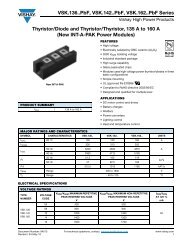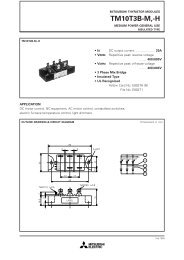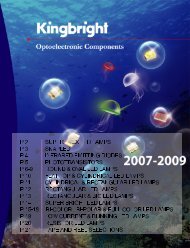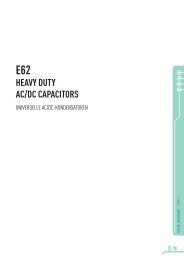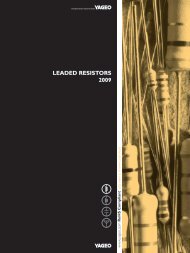ELECTROLYTIC CAPACITORS 2008
ELECTROLYTIC CAPACITORS 2008
ELECTROLYTIC CAPACITORS 2008
- No tags were found...
Create successful ePaper yourself
Turn your PDF publications into a flip-book with our unique Google optimized e-Paper software.
1-4 Basic Electrical Characteristics1. Capacitance (E.S.C.)Fig.1-3C : Capacitance(F)R : Equivalent series resistanceL : Equivalent aeries inductance(H)Simplified equivalent circuit diagram of an electrolytic capacitorDFThe capacitive component of the equivalent series circuit (equiv alent seriescapacitance ESC) is determined by applying an alternate voltage of 0.5V at afrequency of 120 Hz .Temperature dependence of the capacitanceThe capacitance of an electrolytic capacitor depends on the temperature : withdecreasing temperature , the viscosity of the electrolyte increa ses reducing itsconductivity . The capacitance will decrease if the temperature decreases .Furthermore temperature drifts cause armature dilatation and the reforecapacitance changes (up to 20% , depending on the series considered, from 0 to80° C) . This phenomenon is more evident for electrolytic capacitors than forother types .DFTemperature( C )Fig. 1-7 Dissipation factor vs. temperatureFrequencyCAPFig. 1-8 Dissipation factor vs. frequencyFig. 1-4 Capacitance change vs. temperatureFrequency dependence of the capacitanceThe effective capacitance value is derived from the impedance curve , as longas the impedance is still in the range where the capacitance component isdominant .c21f ZTemperature( C)C = Capacitance(F)f = Frequency(Hz)Z = Impedance( )3. Equivalent series resistance (E.S.R.)The equivalent series resistanceis the resistive component of the equivalent seriescircuit . The ESR value depends on frequency and temperature and is related tothe tan by the following equation :ESRThe tolerance limits of the rated capacitance must be taken into account whencalculating this value .tan2 fESCESR = Equivalent Series Resistance( )tan = Dissipation FactorESC = Equivalent Series Capacitance(F)f = Frequency (Hz)CAPESRFrequencyFig. 1-5 Capacitance change vs. frequency2. Dissipation factor (tan )The dissipation factor is the ratio between the active and the reactive power fora sinusoidal waveform voltage . It can be thought as a measurement of the gapbetween an actual and an ideal capacitor .Temperature( C)Fig. 1-9 ESR change vs. temperatureThe resistance of the electrolyte decreases strongly withincreasing temperature.D.F. = tan x 100 (%) = CR x 100 (%)= 2 fCR x 100 (%)ESRFig. 1-6where: R = Equivalent Series ResistanceC = Equivalent Series Capacitancew = 2 fFrequencyFig. 1-10 ESR change vs. frequencyThe tan is measured with the same set up as for the series capacitance ESC .




